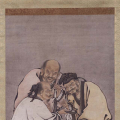Welcome home! Please contact lincoln@icrontic.com if you have any difficulty logging in or using the site. New registrations must be manually approved which may take several days. Can't log in? Try clearing your browser's cookies.
discomfort without aversion
 blu3ree
Veteran
blu3ree
Veteran
http://buddhismnow.com/2013/09/15/discomfort-without-aversion-a-little-miracle-by-corrado-pensa/
tired of uneccesary suffering? be.
We say that mental activity is the problem. But this is certainly not the case! Many of you may be familiar with the famous Fire Sermon of the Buddha where basically he says, ‘The mind is not the problem; the senses are not the problem; the objects of the senses and of the mind are not the problem. The problem is the relationship between the mind and its objects, between the senses and their objects. And this relationship is charged with attachment, aversion and ignorance. So the problem is in the relationship; it is not in the mind or in the objects of the mind; it is not in the mental activity. And yet that mental activity is impregnated with what is called the kilesas, the toxins, attachments, fears, aversions, ignorance. This is the important thing in considering proliferation, in considering and reflecting on papanca.
The aggregates which make up our mind and body are called ‘aggregates of attachment’, upadanakkhandha. In other words, our mental activity is so impregnated by the afflictions, by the kilesas (attachment is just one word which includes all the kilesas in the classical Buddhist tradition) that the entire mental activity has that attachment as its main and fundamental mark. What happens through practising the dharma, through practising meditation, however, is that a gradual purification takes place so that the khandhas, the aggregates, become purer and purer, and in the end are called visuddhi-khandha, pure aggregates. No more aggregates of attachment, no more mind of attachment, but a pure mind, a mind which instead of generating attachment and suffering, now generates dharma.
tired of uneccesary suffering? be.
We say that mental activity is the problem. But this is certainly not the case! Many of you may be familiar with the famous Fire Sermon of the Buddha where basically he says, ‘The mind is not the problem; the senses are not the problem; the objects of the senses and of the mind are not the problem. The problem is the relationship between the mind and its objects, between the senses and their objects. And this relationship is charged with attachment, aversion and ignorance. So the problem is in the relationship; it is not in the mind or in the objects of the mind; it is not in the mental activity. And yet that mental activity is impregnated with what is called the kilesas, the toxins, attachments, fears, aversions, ignorance. This is the important thing in considering proliferation, in considering and reflecting on papanca.
The aggregates which make up our mind and body are called ‘aggregates of attachment’, upadanakkhandha. In other words, our mental activity is so impregnated by the afflictions, by the kilesas (attachment is just one word which includes all the kilesas in the classical Buddhist tradition) that the entire mental activity has that attachment as its main and fundamental mark. What happens through practising the dharma, through practising meditation, however, is that a gradual purification takes place so that the khandhas, the aggregates, become purer and purer, and in the end are called visuddhi-khandha, pure aggregates. No more aggregates of attachment, no more mind of attachment, but a pure mind, a mind which instead of generating attachment and suffering, now generates dharma.
2


Comments
Great article, though.
Oh, okay.
Thank you the clarification.